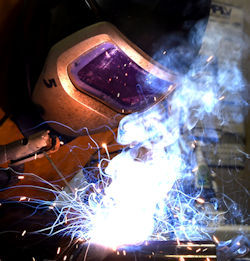Arc Welding Hazards and Precautions
Fumes and Gases
Fumes produced during welding are composed of very small, easily inhaled solid particles, produced by the heat generated when welding consumables, base metals, and base metal coatings.
Shielding gases (argon, helium, carbon dioxide, etc.) may be used to protect and enhance the properties of the weld. They may present a health hazard by displacing oxygen that can result in the welder experiencing dizziness, unconsciousness, and death.
Process gases (nitric oxide, nitrogen dioxide, carbon monoxide, ozone, phosgene, hydrogen fluoride, and carbon dioxide) may also be a byproduct of the welding process itself.
Welding fumes and gases generally come from the following sources:
- base material being welded or the filler material used
- coatings and paints on the metal or electrode coatings;
- shielding gases supplied from cylinders;
- chemical reactions due to ultraviolet light of the arc and heat; and
- contaminants in the air from cleaners and degreasers.
Exposure to welding fumes and gases can have serious negative health effects. Health hazards associated with welding include:
- Acute exposure to welding fumes and gases can result in eye, nose and throat irritation, dizziness and nausea. Workers in the area who experience these symptoms should leave the area immediately, seek fresh air and obtain medical attention.
- Prolonged exposure to welding fumes may cause lung damage and various types of cancer, including lung, larynx and urinary tract.
- Health effects from certain fumes may include metal fume fever, stomach ulcers, kidney damage and nervous system damage. Prolonged exposure to manganese fumes can cause Parkinson’s–like symptoms.
- Gases such as helium, argon, and carbon dioxide displace oxygen in the air and can lead to suffocation, particularly when welding in confined or enclosed spaces. Carbon monoxide gas can form, posing a serious asphyxiation hazard.
Knowledge Check Choose the best answer for the question.
1-10. What negative health effect may occur from prolonged exposure to welding fumes?
You forgot to answer the question!

